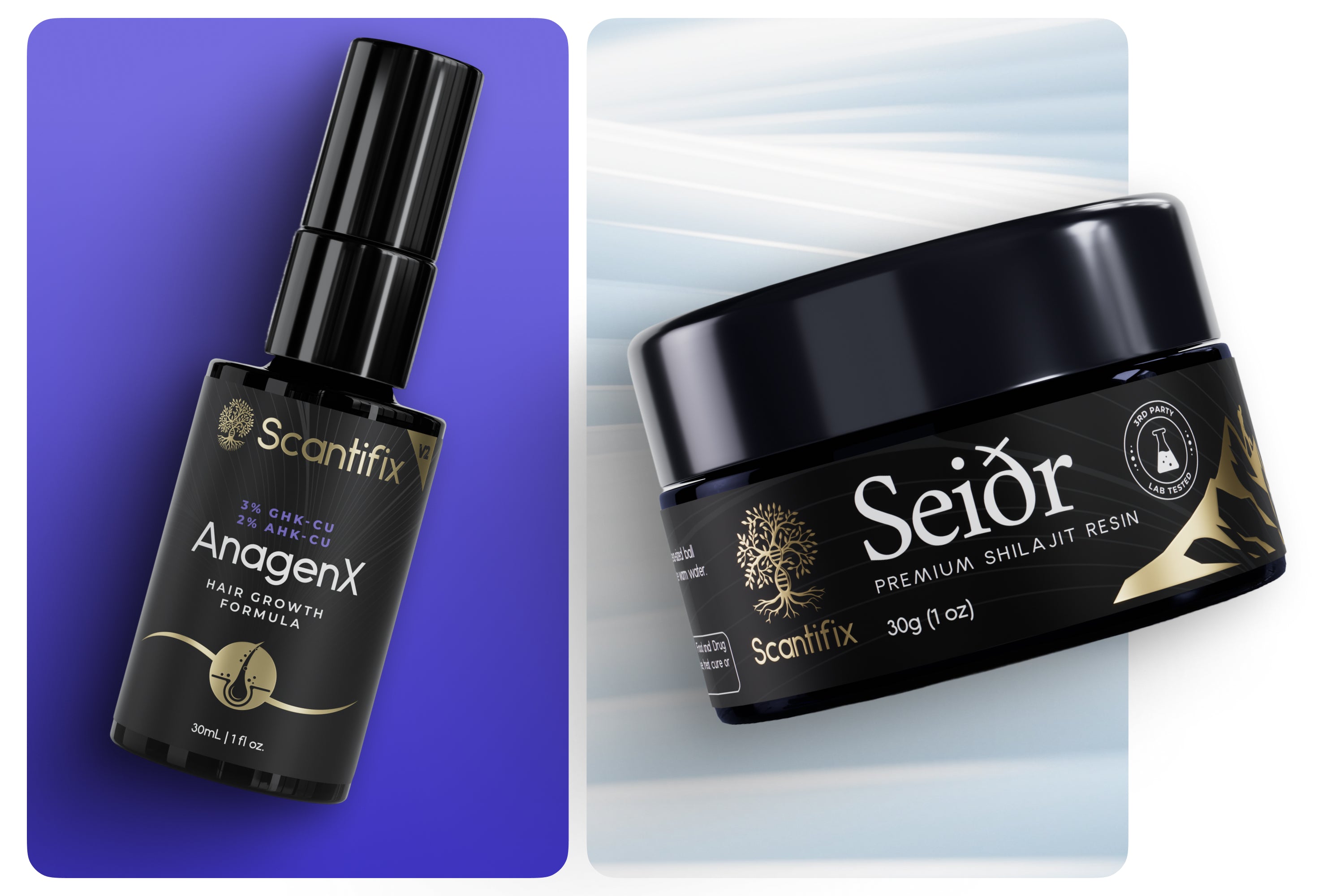When it comes to softening expression lines, many people feel stuck between underwhelming topical products and invasive treatments that change how you look and move. Neuromodulatory peptides offer a middle ground as topical solutions that can deliver visible results while keeping natural facial movement.
These peptides work with your skin’s own biology to reduce the small, repetitive muscle contractions that deepen creases (Waszkielewicz & Mirosław, 2024). By calming targeted areas beneath the skin, they help the surface appear smoother and more rested over time.
Research shows that layering complementary peptides, a method called stacking, can target multiple points in wrinkle formation for broader, more effective results (Pintea et al., 2025). One of the most effective stacks combines Argireline, SNAP-8, and Leuphasyl. In the sections ahead, we’ll explore what each peptide does, how they work together for maximum effect, and how you can incorporate this stack into your skincare regimen.
But first, let’s take a look at what causes expression lines so we can better understand how to treat them.
How Expression Lines Form
Expression lines such as crow’s feet, forehead creases, and frown lines develop through years of repeated muscle activity beneath the skin (Schagen, 2017):
-
- Nerve endings release acetylcholine, a neurotransmitter, into the neuromuscular junction.
- This release depends on the SNARE complex, a group of proteins that send the contraction signal, including SNAP-25.
- Acetylcholine binds to receptors on muscle cells, causing them to contract.
- Over time, repeated folding leads to permanent lines.
There’s other factors that can accelerate this process. Sun exposure weakens collagen and elastin, making skin less able to bounce back after repeated folding. Dehydration, stress, and lifestyle habits like smoking can also reduce the skin’s resilience. This combination of mechanical stress and biological aging is why lines that start as faint creases can eventually deepen and remain visible even at rest.
The popular botulinum toxin treatments (such as Botox®, Dysport®, and others) break down SNARE proteins, stopping acetylcholine release entirely. Neuromodulatory peptides aim to interrupt this cycle at the signaling level, helping keep skin movement softer and less damaging over time. (Waszkielewicz & Mirosław, 2024).
Argireline: The First Topical SNARE Modulator
Argireline (Acetyl Hexapeptide-8) mimics part of the SNAP-25 protein, reducing the release of acetylcholine and making it harder for small facial muscles to contract fully (Khalid et al., 2015).
Because it targets the earliest step in the contraction pathway, Argireline can be especially useful for areas where lines form from frequent, high-intensity movements, like the corners of the eyes from squinting or the forehead from raising brows. In a four-week clinical trial, twice-daily use reduced eye-area wrinkle depth by nearly 49% without irritation (Wang et al., 2013).
By gently limiting the signal before it reaches the muscle, it helps the skin recover a smoother, more relaxed look without any change in natural expression. With its proven track record and non-invasive delivery, topical Argireline is a reliable and less risky approach for tackling fine lines.
SNAP-8: Designed for Greater Potency
SNAP-8 (Acetyl Octapeptide-3) is a modified version of Argireline with two extra amino acids for improved flexibility and binding (Khalid et al., 2015).
It works on the same SNARE complex, but its modification means it can more effectively compete with native SNAP-25 to further inhibit acetylcholine release. This allows for a slightly greater reduction in muscle contraction and improved performance in harder-to-penetrate areas or deeper lines. It can also be effective in lower concentrations, helping to minimize potential irritation.
Studies on SNAP-8 report up to a 34.9% wrinkle depth reduction in 28 days, with excellent tolerability (Nguyen et al., 2024). And when paired with Argireline, the two peptides create a more complete presynaptic strategy. Argireline initiates the signal reduction and SNAP-8 reinforces it to help deliver enhanced overall results. (Pintea et al., 2025).
Leuphasyl: Calming the Muscle Response
Leuphasyl (Pentapeptide-18) acts on the muscle side of the process, after the nerve has sent its signal. It mimics natural peptides called enkephalins to attach to muscle cell receptors, encouraging them to relax (Khalid et al., 2015).
This keeps targeted muscles slightly more at rest during expressions, reducing the mechanical stress on the skin and supporting smoother texture over time. In clinical testing, Leuphasyl at up to 2% concentration reduced wrinkle depth without irritation (Dragomirescu et al., 2014).
Because it works after the signal reaches the muscle, Leuphasyl is particularly effective in combination formulas aimed at more established lines. It complements Argireline and SNAP-8 by addressing a different stage of the pathway (Pintea et al., 2025).
Let’s take a closer look at how these three peptides interact to provide comprehensive skin smoothing benefits.
Why They Work Better Together
Each of these peptides works at a different point in the chain of events that leads to expression lines:
-
- Argireline: Helps quiet the “contract” signal that travels from nerve to muscle.
- SNAP-8: Fine-tunes that signal even further, for gentler, more relaxed movement.
- Leuphasyl: Steps in at the muscle level, helping it respond less strongly when the signal arrives (Khalid et al., 2015).
Because they act in different ways, they can complement each other rather than compete (Pintea et al., 2025). This allows for a balanced approach with lower amounts of each ingredient, reducing the chance of irritation while still supporting visible smoothing over time (Khalid et al., 2015). Together, they smooth the skin by easing muscle contractions, softening lines while avoiding the “frozen” or unnatural look some treatments cause, so your expressions stay natural and your skin looks more relaxed.
One more added benefit of this trio of topical peptides is how much easier they can fit into your skincare regimen compared to more clinical treatments.
How to Incorporate This Peptide Stack Into Your Routine
If you’re interested in trying Argireline, SNAP-8, and Leuphasyl together, you have two main options:
-
- Pre-made formulations: Look for professionally developed serums or creams that feature all three peptides, often alongside hydrators like hyaluronic acid and barrier-supporting ingredients such as niacinamide. These products are designed for stability, optimal concentrations, and ease of use.
- Custom blends with raw peptides: For full control, use high-purity, raw peptides, like those from Scantifix, to create your own serum. Raw peptides can be reconstituted and combined in a compatible base, such as a hyaluronic acid gel. Every peptide is different, but for this particular stack, it’s recommended to keep pH between 5.5–6.5 and to avoid strong acids or oxidizing agents. Raw peptides and finished serums should be kept in airtight, light-protective glass and kept cool and dry to maintain potency. Always follow formulation best practices or consult a dermatologist if you're unsure.
Choosing Argireline, SNAP-8, and Leuphasyl from a trusted source is just as important as knowing how to use them. At Scantifix, we provide these peptides at the highest purity, with every batch rigorously third-party tested and accompanied by a Certificate of Analysis (COA) so you can feel confident in their potency and effectiveness. Head over to our shop to browse our selection of high-quality raw peptides.
Final Thoughts: An Updated Approach to Expression Lines
Research continues to reveal the benefits of topical neuromodulatory peptides and expanding the options available to us in modern skincare strategies. Argireline, SNAP-8, and Leuphasyl have been proven effective on their own, but when stacked, they complement each other and offer a more complete approach. By addressing wrinkles from both the nerve and muscle side, they smooth expression lines while keeping your natural look intact. If you’ve ever felt limited to either underwhelming topicals or invasive procedures, this trio offers a third option that delivers visible results without any of the downside.
Resources
Dragomirescu, A., Andoni, M., Ionescu, D., & Andrei, F. (2014). The efficiency and safety of Leuphasyl—A Botox-like peptide. Cosmetics, 1(2), 75–87. https://doi.org/10.3390/cosmetics1020075
Khalid, F., Gorouhi, F., & Maibach, H. I. (2015). Anti-aging topical peptides and proteins. In Z. Draelos (Ed.), Cosmeceuticals and active cosmetics (3rd ed., pp. 327–344). CRC Press. https://doi.org/10.1201/b18895-17
Nguyen, T., Lee, J., & Kim, S. (2024). Sustainable dynamic wrinkle efficacy: Neuromodulatory peptide analogs for vegan-friendly formulations. Cosmetics, 11(4), 118. https://doi.org/10.3390/cosmetics11040118
Pintea, M., Popescu, R., & Ionescu, M. (2025). Peptides: Emerging candidates for the prevention and treatment of skin senescence. Biomolecules, 15(1), 88. https://doi.org/10.3390/biom15010088
Schagen, S. K. (2017). Topical peptide treatments with effective anti-aging results. Cosmetics, 4(2), 16. https://doi.org/10.3390/cosmetics4020016
Wang, Y., Wang, M., Xiao, S., Pan, P., Li, P., & Huo, J. (2013). The anti-wrinkle efficacy of Argireline, a synthetic hexapeptide, in Chinese subjects. American Journal of Clinical Dermatology, 14(4), 277–284. https://doi.org/10.1007/s40257-013-0009-9
Waszkielewicz, A., & Mirosław, B. (2024). Peptides and their mechanisms of action in the skin. Applied Sciences, 14(24), 11495. https://doi.org/10.3390/app142411495






Leave a comment
All comments are moderated before being published.
This site is protected by hCaptcha and the hCaptcha Privacy Policy and Terms of Service apply.